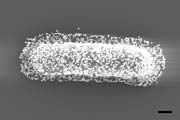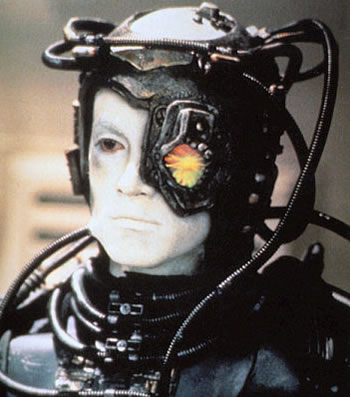Science Fiction
Dictionary
A B C D E F G H I J K L M N O P Q R S T U V W X Y Z
'Cellborg' Humidity Gauge First Bacterial Cyborg

Chemists at the University of Nebraska have created a humidity gauge by actually 'assimilating' living bacteria into an electronic circuit. This appears to be the first instance in which a living cell becomes a fixed part of the structure of an electronic device.

('Cellborg' - first bacterial cyborg)
Ravi Saraf and student Vikas Berry made their device from a standard silicon chip inlaid with gold electrodes. First they added a coating of Bacillus cereus bacteria, which clustered together to form bridges between the electrodes. Then they washed the chip with a solution of gold particles, each of which measured about 30 nanometres across and was covered with peptides to help it stick to the bacteria.
A rise in moisture levels causes the bacteria to swell slightly, which increases the distance between neighbouring nanoparticles by up to 0.2 nanometres. This tiny separation makes it harder for electrons to hop from one particle to the next, which reduces the current flowing across the chip. A change from 20% to 0% humidity increased the current flowing through the device by 40 times, whereas the current in a solely electronic device decreases by just ten times.
The bacteria must stay alive during their assimilation so that they do not leak any internal fluids and lose their shape. According to Saraf, the bacteria can survive for about two days without nutrients. However, the device continues to work even after the bacteria die; the zombie 'borg-teria' continue to work for as long as a month after death.

(Hugh - the Borg drone)
Science fiction fans are well aware of the 'cellborgs' namesake - the Borg collective of cyborgs (cybernetic organisms) who stop at nothing in their relentless pursuit of assimilating other intelligent organisms.
In the series (and associated films), captured human beings are outfitted with mechanical and electrical parts that will make them serviceful to the collective.
Saraf speculates that similar devices could one day be made that take greater advantage of living organisms, perhaps even using bacteria's energy systems to power electrical devices. But that will involve going one step further: using a physiological rather than physical response of a bacteria. "One still needs to demonstrate that an electronic coupling between the biology of the microorganism and a nanodevice is possible," he adds.
Read Cyborg cells sense humidity.
Scroll down for more stories in the same category. (Story submitted 10/18/2005)
Follow this kind of news @Technovelgy.| Email | RSS | Blog It | Stumble | del.icio.us | Digg | Reddit |
Would
you like to contribute a story tip?
It's easy:
Get the URL of the story, and the related sf author, and add
it here.
Comment/Join discussion ( 3 )
Related News Stories - (" Medical ")
Bone-Building Drug Evenity Approved
'Compounds devised by the biochemists for the rapid building of bone...' - Edmond Hamilton, 1932.
BrainBridge Concept Transplant Of Human Head Proposed
'Briquet’s head seemed to think that to find and attach a new body to her head was as easy as to fit and sew a new dress.' - Alexander Belaev (1925)
Natural Gait With Prosthetic Connected To Nervous System
'The leg was to function, in a way, as a servo-mechanism operated by Larry’s brain...' - Charles Recour, 1949.
Brain Implant Is Able To Capture Your Inner Dialogue
'So you see, you can hide nothing from me.'
Technovelgy (that's tech-novel-gee!) is devoted to the creative science inventions and ideas of sf authors. Look for the Invention Category that interests you, the Glossary, the Invention Timeline, or see what's New.
Science Fiction
Timeline
1600-1899
1900-1939
1940's 1950's
1960's 1970's
1980's 1990's
2000's 2010's
Current News
Bone-Building Drug Evenity Approved
'Compounds devised by the biochemists for the rapid building of bone...'
Secret Kill Switch Found In Yutong Buses
'The car faltered as the external command came to brake...'
Inmotion Electric Unicycle In Combat
'It is about the size and shape of a kitchen stool, gyro-stabilized...'
Grok Scores Best In Psychological Tests
'Try to find out how he ticks...'
PaXini Supersensitive Robot Fingers
'My fingers are not that sensitive...'
Congress Considers Automatic Emergency Braking, One Hundred Years Too Late
'The greatest problem of all was the elimination of the human element of braking together with its inevitable time lag.'
The Desert Ship Sailed In Imagination
'Across the ancient sea floor a dozen tall, blue-sailed Martian sand ships floated, like blue smoke.'
The Zapata Air Scooter Would Be Great In A Science Fiction Story
'Betty's slapdash style.'
Thermostabilized Wet Meat Product (NASA Prototype)
There are no orbiting Michelin stars. Yet.
Could Crystal Batteries Generate Power For Centuries?
'Power could be compressed thus into an inch-square cube of what looked like blue-white ice'
India Ponders Always-On Smartphone Location Tracking
'It is necessary... for your own protection.'
Amazon Will Send You Heinlein's Knockdown Cabin
'It's so light that you can set it up in five minutes by yourself...'
Is It Time To Forbid Human Driving?
'Heavy penalties... were to be applied to any one found driving manually-controlled machines.'
Replace The Smartphone With A Connected Edge Node For AI Inference
'Buy a Little Dingbat... electropen, wrist watch, pocketphone, pocket radio, billfold ... all in one.'
Artificial Skin For Robots Is Coming Right Along
'... an elastic, tinted material that had all the feel and appearance of human flesh and epidermis.'
Robot Guard Dog On Duty
I might also be thinking of K-9 from Doctor Who.
